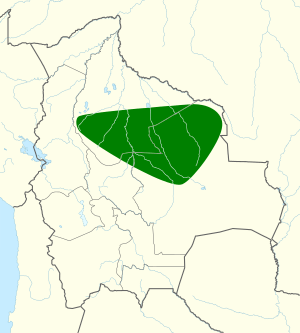Unicolored thrush facts for kids
Quick facts for kids Unicolored thrush |
|
|---|---|
| Conservation status | |
| Scientific classification | |
 |
The Unicolored Thrush (Turdus haplochrous) is a special kind of bird that belongs to the Turdidae family, which includes many types of thrushes. This bird is unique because it is endemic to Bolivia. This means you can only find it living naturally in Bolivia and nowhere else in the world!
Its home is usually in warm, wet lowland forests. These forests are often called subtropical or tropical moist lowland forests. They are full of tall trees and lots of plants, making a perfect place for the Unicolored Thrush to live.
Contents
About the Unicolored Thrush
The Unicolored Thrush is a medium-sized bird, like many other thrushes. It gets its name "unicolored" because its feathers are mostly one color, often a plain brown or olive-brown, without many bright markings. This helps it blend in with the trees and leaves in its forest home, making it harder for predators to spot.
Where the Unicolored Thrush Lives
As mentioned, the Unicolored Thrush lives only in Bolivia, a country in South America. It prefers specific types of forests that are warm and have a lot of rain. These lowland forests are usually found at lower elevations, not high up in the mountains. The dense trees and rich plant life provide plenty of food and safe places for the birds to build their nests.
What the Unicolored Thrush Eats
Like many thrushes, the Unicolored Thrush likely eats a variety of things it finds on the forest floor or in the trees. Their diet often includes insects, worms, and small fruits or berries. They use their strong beaks to search for food among the leaves and soil.
Conservation Status
The Unicolored Thrush is currently listed as "Near Threatened" (NT) by the IUCN. This means that while it's not in immediate danger of disappearing, its population might become threatened in the future. The main reason for this concern is often the loss of its forest habitat due to things like logging or turning forests into farmland. Protecting these unique forests is very important to help the Unicolored Thrush survive.
See also
- Zorzal boliviano para niños (Unicolored Thrush for kids in Spanish)


